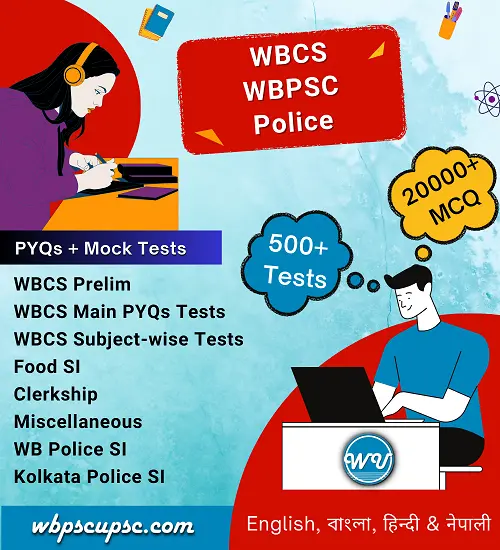Contents

wbcs main ancient history questions
WBCS Main Question Paper – 2023
1. Chandragupta Maurya was a follower of
(A) Jainism
(B) Buddhism
(C) Ajivika religion
(D) Saivism
2. Which ancient Indian ruler was the Chief patron of the fourth Buddhist Council?
(A) Ashoka
(B) Kanishka
(C) Ajatashatru
(D) Samudragupta
3. Who composed the ‘Milinda Panho‘?
(A) Vasumitra
(B) Nagasena
(C) Ashvaghosha
(D) Dharmakirti
6. During Alexander’s invasion who was the then ruler of Magadha?
(A) Dhanananda
(B) Chandragupta Maurya
(C) Puru
(D) Ambhi
9. Which Gupta ruler saved the Gupta Empire from the invasion of the Hunas?
(A) Skandagupta
(B) Budhagupta
(C) Tathagata Gupta
(D) Vishnu Gupta
18. The School of Gandhara Art flourished during the reign of the
(A) Mauryan Dynasty
(B) Kushan Dynasty
(C) Satavahana Dynasty
(D) Gupta Dynasty
24. The capital of the Pallava rulers was
(A) Hampi
(B) Dwarka
(C) Kanchipuram
(D) Ujjain
31. Which dynasty ruled over Magadha before the Mauryan dynasty?
(A) Satavahana
(B) Sunga
(C) Nanda
(D) Kanva
33. Who composed the ‘Artha Sastra’?
(A) Kautilya
(B) Barahamihira
(C) Aryabhatta
(D) Patanjali
34. Which Gupta ruler took the title of ‘Vikramaditya’?
(A) Chandragupta I
(B) Samudragupta
(C) Chandragupta II
(D) Skandagupta
35. The Kailasanath temple in Kanchipuram was built by the
(A) Cholas
(B) Pallavas
(C) Pandyas
(D) Guptas
44. Which God was known as ‘Purandar‘ to the Vedic people?
(A) Lord Shiva
(B) Indra
(C) Varuna
(D) Agni
50. Lothal is located at
(A) Rajasthan
(B) Uttar Pradesh
(C) Gujarat
(D) Haryana
53. ‘Battle of Ten Kings‘ was described in
(A) The Rig Veda
(B) The Sama Veda
(C) The Yajur Veda
(D) The Atharva Veda
75. Which was the Capital City of Magadha during the reign of Chandragupta Maurya?
(A) Amaravati
(B) Pataliputra
(C) Ujjain
(D) Kannauj
77. Who had Nine Jewels in his royal court?
(A) Chandragupta II
(B) Samudragupta
(C) Chandragupta I
(D) Chandragupta Maurya
81. The Nasik inscription gives us information about
(A) The Vakatakas
(B) The Rastrakutas
(C) The Satavanhanas
(D) The Guptas
89. Who composed the ‘Buddhacharita‘?
(A) Ashvaghosa
(B) Basumitra
(C) Nagasena
(D) None of the above
96. Which Mahajanapada of 6th century BCE was an aristocratic-oligarchic republic (a confederacy of eight clans governed in accordance with republican principles)?
(A) Magadha
(B) Vajji
(C) Kashi
(D) Koshala
97. Who composed ‘Nagananda‘ and ‘Ratnabali‘?
(A) Harshavardhana
(B) Kanishka
(C) Samudragupta
(D) Chandragupta II
100. From which inscription we get important information about the Saka ruler Rudra Damana?
(A) Junagarh inscription
(B) Aihole inscription
(C) Allahabad Pillar inscription
(D) Bhitari Pillar inscription
WBCS Main Question Paper – 2022
- The “Three Jewels” are to be found in
(A) Vaishnavism
(B) Buddhism
(C) Judaism
(D) Jainism (Tri-Ratnas)
(Question canceled by PSC)
- The capital of the Magadhan Empire under Bimbisara was
(A) Girnar
(B) Girivraja
(C) Gauda
(D) Gujarat
- What was importance of Lothal?
(A) Port
(B) Granary
(C) Zoo
(D) Market
- The first ruler of the Pala Dynasty was
(A) Devpala
(B) Dharmapal
(C) Gopal
(D) Tejpal
(A) Bimbisara
(B) Ajatasatru
(C) Kanishka
(D) Menander
- Karshapana was a type of
(A) Metal
(B) Paper
(C) Currency
(D) Race
- The Maurya Emperor who propounded the concept of “Dhamma” had been
(A) Chandragupta
(B) Bindusara
(C) Ashoka
(D) None of the above
- The last Buddhist Council was held at
(A) Sarnath
(B) Kundavalan
(C) Saket
(D) Ceylon
- The twenty third Tirthankara was
(A) Parshvanath
(B) Vardhaman Mahavira
(C) Gautam Buddha
(D) Ajatasatru
- The Vedas were
(A) Sacred Book of the Aryans
(B) Genealogical History
(C) Artefacts
(D) Language
- Bimbisara was from the
(A) Gupta Dynasty
(B) Haryanka Dynasty
(C) Maurya Dynasty
(D) Khilji Dynasty
- Where was the figure of the dancing girl to be found?
(A) Indus Valley
(B) Araku Valley
(C) Kashmir Valley
(D) Nubra Valley
- Who was known as the “Indian Napoleon”?
(A) Kumargupta
(B) Skandagupta
(C) Samudragupta
(D) Yasodharman
(A) Greece
(B) Iran
(C) Central Asia
(D) Europe
- The Allahabad Pillar Inscription dates back to the
(A) Maurya period
(B) Gupta period
(C) Kushan period
(D) Saka period
(A) Bimbisara and Ajatasatru
(B) Bimbisara and Porus
(C) Porus and Alexander
(D) None of the above
(A) Chandragupta Maurya
(B) Bimbisara
(C) Kanishka
(D) Megasthanes
- The book ‘Indica’ was written by
(A) Fa Hien
(B) Hiuen Tsang
(C) Megasthenes
(D) Asvaghosa
- The following was a Mahajanapada:
(A) Magadha
(B) Saurashtra
(C) Pragjyotishpur
(D) Sialkot
- Gautam Buddha was from the following clans:
(A) Vajji
(B) Sakya
(C) Kushan
(D) Saka
- The Garuda Pillar at Besnagar was endowed by
(A) Heliodorus
(B) Megasthenes
(C) Bimbisara
(D) Ajatasatru
- ‘Arthashastra’ was written by
(A) Chandragupta
(B) Bimbisara
(C) Kautilya
(D) None of the above
- The Buddha gave his first sermon at
(A) Gaya
(B) Sarnath
(C) Peshawar
(D) Karnataka
- Tamralipta was a
(A) River
(B) Canal
(C) Port
(D) Fort
(A) Chandragupta I
(B) Samudragupta
(C) Kumargupta
(D) Budhagupta
- The term “ Sakari” was used for
(A) Chandragupta II Vikramaditya
(B) Samudragupta
(C) Kumargupta
(D) Skandagupta
- The “Milinda Panho” was a
(A) Scripture
(B) Book on Philosophical discussion
(C) Artefact
(D) Cinema
- The last ruler of the Maurya Dynasty was
(A) Ajatasatru
(B) Bimbisara
(C) Brihadratha
(D) Kakavarna
(A) Kanauj
(B) Pataliputra
(C) Gaur
(D) Assam
- The Central Asian theory of the home of the Aryans was propounded by
(A) Friedrich Max Muller
(B) Nirad Chaudhary
(C) Rakhaldas Banerjee
(D) Risley
- The Chinese pilgrim Fa Hien had visited India during the reign of
(A) Chandragupta II Vikramaditya
(B) Bimbisara
(C) Harshavardhan
(D) Kharvela
- The Eight-Fold path in Buddhism is known as
(A) Dharmachakrapravartana
(B) Ashtangik Marg
(C) Nirukta
(D) Vimukta
- The author of ‘Harshacharita’ was
(A) Nagarjuna
(B) Banabhatta
(C) Aryabhatta
(D) Varahamihir
- Mohenjodaro and Harappa belong to
(A) Egyptian civilization
(B) Sumerian civilization
(C) Mesopotamian civilization
(D) Indus Valley civilization
- Menander was a
(A) Kushan
(B) Indo-Greek
(C) Saka
(D) Chinese
- The oldest Veda was
(A) Rig Veda
(B) Sam Veda
(C) Atharva Veda
(D) Avesta
- The capital of Kanishka was
(A) Purushpura
(B) Sialkot
(C) Pathankot
(D) Bodhgaya
- The greatest Kushan ruler was
(A) Menander
(B) Gondophernes
(C) Maga
(D) Kanishka
- Who was known as “Beloved of the Gods”?
(A) Kalshoka
(B) Bimbisara
(C) Ajatasatru
(D) Ashoka
WBCS Main Question Paper – 2021
19. The river mentioned most frequently in the Rig Vedic hymns was
(A) Ganga
(B) Yamuna
(C) Sutlej (Satadru)
(D) Saraswati
35. Which Indian geographer had given information about Solar and Lunar eclipses?
(A) Aryabhatta
(B) Varah Mihir
(C) Brahmagupta
(D) Bhaskaracharya
39. Which ruler of Magadha was called ‘Amitrochates’ (Amitraghata – Slayer of Enemies) in Greek records?
(A) Bimbisara
(B) Ajatashatru
(C) Bindusara
(D) Asoka
43. The main sources of ancient Indian Geographical concepts are
(A) Hindu Mythology
(B) Travellers Account
(C) Sacred Laws
(D) All of the above
72. Ancient Indian Geography hinges on
(A) Systematic Study
(B) Observation
(C) Religion
(D) Scientific Laws
161. Which of the following statements is true of the Harappan civilisation?
(i) Harappan civilisation comprised of a network of urban constellations, drawing on the agricultural surplus generated by the surrounding countryside.
(ii) The Harappans seem to have flourishing trade relation with Sumeria and Egypt.
(iii) The seals are suspected to be connected with trading activities of the Harappans.
(iv) Overland trade rested primarily on bullock and horse-drawn carriages.
(v) Some deities akin to the mothergoddess and Pashupati seem to have been popular.
(A) (i), (ii), (iii)
(B) (i), (ii), (iii), (v)
(C) (ii), (iv), (v)
(D) (iii), (iv)
176. Which is our earliest source for the existence of untouchables in India?
(400–350 BCE)
(A) Atharva Veda
(B) Chandogya Upanishad
(C) Panini’s Ashtadhyayi
(D) Harshacharita
182. What were villages granted to Brahmins and inhabited by Brahmins known as?
(A) Devadana
(B) Brahmadeya
(C) Agrahara
(D) Mangalam
WBCS Main Question Paper – 2020
2. What is the meaning of the word ‘Sangam’ in the Sangam Age?
(A) Royal Court
(B) Assembly of Poets
(C) Assembly of religious teachers
(D) Meeting of rivers
3. Who composed the Sanskrit kavya ‘Saundarananda’?
(spiritual adviser of Kanishka)
(A) Asvaghosa
(B) Kalidasa
(C) Nagarjuna
(D) Visnu Sharma
5. Rulers of which dynasty patronised Jainism?
(6th – 12th century)
(A) Chalukya
(B) Pallava
(C) Rashtrakuta
(D) Chauhan
14. The learned lady who is said to have debated with the famous law-giver Yajnavalkya was
(9th – 7th century BCE)
(A) Gargi
(B) Maitreyi
(C) Kamala
(D) Kalindi
15. The river Chenab was known in the Vedic period by the name of
(A) Asikni
(B) Purushni
(C) Vitasta
(D) Shutudri
18. What was the ‘Araghatta’?
(A) A machine to break forts
(B) An irrigation canal
(C) A device to lift water
(D) A type of cloth
28. Which of the following statements is incorrect about the position of women during the age of Buddha?
(A) The position of women generally deteriorated
(B) There were several instances of child marriages.
(C) Polygamy was gradually growing among the ruling classed.
(D) Education was denied to women.
32. Which of the following was the basic unit of Vedic society?
(A) Jana
(B) Vidatha
(C) Parivar
(D) Sangh
41. Who was the most important God in the Rigveda?
(A) Agni
(B) Indra
(C) Varun
(D) Vishnu
43. Who among the following scholars declared that the ‘Saptsindhava’ region was the homeland of the Aryans?
(A) Dr. A. C. Das
(B) Prof. Max Muller
(C) Prof. Karl Penta
(D) Dr. K. K. Sharma
47. The Nayanar group of saints in North India were devotees of Lord
(A) Vishnu
(B) Shiva
(C) Krishna
(D) Buddha
53. Which of the following is the biggest Harappan civilization site?
(A) Ropar
(B) Lothal
(C) Kalibangan
(D) Rakhigarhi
60. The river most mentioned in the Rigveda is
(A) Sindhu
(B) Shutudri
(C) Saraswati
(D) Gandaki
61. “The most unique feature of this site is its dockyard; the world’s first tidal port, which served as a main seaport for the Indus people”.
The above statement holds true for which site?
(A) Ropar
(B) Lothal
(C) Rakhigarhi
(D) Banawali
64. The word ‘Veda’, derived from ‘Vid’ refers to
(A) Knowledge
(B) Energy
(C) Truth
(D) Karma
71. Which dynasty ruled over Magadha after the Mauryan dynasty?
(A) Satavahana
(B) Sunga
(C) Nanda
(D) Kanva
72. Which particular city became the nodal point for trade routes running from north to south and east to west in the pre-Gupta and Gupta periods?
(Madhya Pradesh)
(A) Taxila
(B) Mathura
(C) Ujjain
(D) Vidisa
76. Vedic literature is also known as
(A) Shruti
(B) Smriti
(C) Sanhita
(D) Vedanga
77. The Indian who was involved in the excavations of Harppa and Mohenjodaro is
(1922)
(A) S.D. Rathore
(B) K.K. Menon
(C) R.D. Banerjee
(D) R.D. Sharma
83. Kalibangan is located at
(A) Gujarat
(B) Rajasthan
(C) Himachal Pradesh
(D) Punjab
86. When and by whom were the Ashokan Inscriptions deciphered for the first time?
(A) 1787 – John Tower
(B) 1810-Harry Smith
(C) 1825 – Charles Metcalfe
(D) 1837 – James Prinsep






